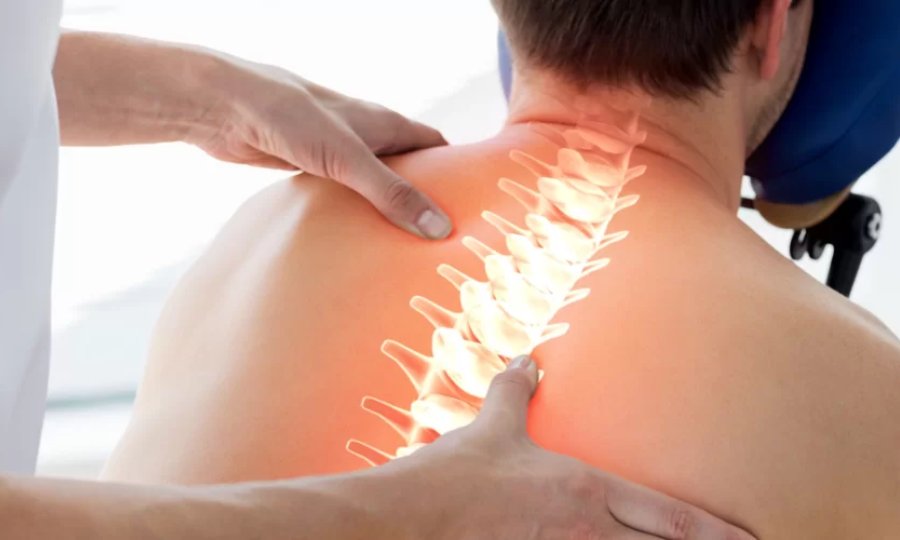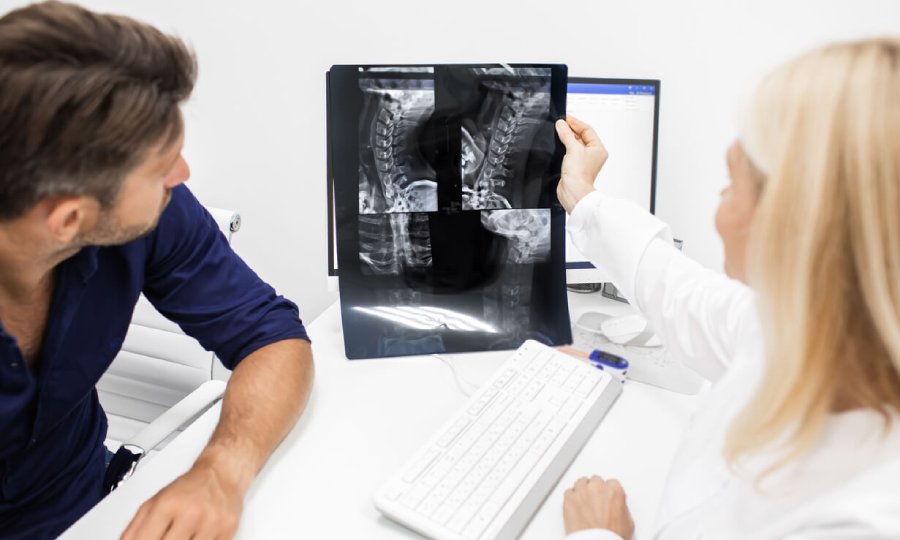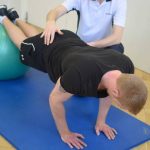Back pain is something that connects all of us. Some of us know it from our own experience, some see it in their loved ones. Problems with the thoracic spine can seriously affect the quality of life, and surgery may be the only solution. But here it’s important to remember one thing: rehabilitation is a critically important element of the recovery process. To skip this step means to risk losing all the benefits of the surgery.
What is Surgery on the Thoracic Spine

Defining Surgery on the Thoracic Spine
Surgery on the thoracic spine includes discectomy (removal of the intervertebral disc), laminectomy (removal of part of the vertebra), fusion (joining of vertebrae), or prosthesis implantation. These surgeries aim to improve the patient’s quality of life, reduce pain, and restore functionality.
What to Expect from the Surgery
Preparation for the surgery and understanding what to expect from it plays a key role in successful recovery. Most patients experience significant pain relief and have improved quality of life after surgery. But don’t forget that the recovery may be long and vary in each individual case.
Post-surgery: Main Limitations
After surgery on the thoracic spine, there are several restrictions that the patient must strictly adhere to:
- Avoid heavy physical exertion: Lifting heavy objects, overly intense physical exercises, especially without support and supervision of a physiotherapist, can lead to strain and damage to the surgical site.
- Limit torso movements: Avoid abrupt movements, bends and turns of the torso, especially in the first few weeks after surgery. This will help avoid unnecessary strain and pressure on the surgery area.
- Don’t ignore pain: If you feel pain while performing any actions, stop immediately. This could be a sign that you are doing something that you should not be doing, or that you are doing it incorrectly.
- Avoid sitting or standing for a long time: Aim to change your body position every 20-30 minutes. Sitting or standing in one position for a prolonged period can increase pressure on the spine and cause pain.
- Don’t neglect physical therapy: Regular exercises are an important part of the recovery process, but they should be done under the supervision of a specialist and all their recommendations should be followed.
- Avoid situations that lead to falling: Falling can cause serious harm to the surgical area. Be especially careful on slippery surfaces and when using stairs.
- Avoid smoking and excessive alcohol consumption: These substances can slow down the recovery process, worsen pain sensations, and increase the risk of complications.
Importance of Rehabilitation after Surgery

Why is rehabilitation important?
Rehabilitation after surgery on the thoracic spine is crucial for the patient’s successful recovery. Here are several main reasons why rehabilitation is so important:
Restoration of physical function: One of the main goals of rehabilitation is to restore the patient’s physical function and mobility. This is achieved with physiotherapy exercises that help strengthen muscles, improve flexibility and coordination, and increase overall endurance.
Pain management: Rehabilitation can also help reduce pain sensations after surgery. This is achieved with various methods, including physiotherapy, medication, and in some cases, psychological support.
Prevention of complications: Adequate rehabilitation helps prevent potential complications after surgery, such as infections, blood clots, or even a repeated surgical intervention. Regular check-ups and following medical recommendations play a key role in preventing these complications.
Improving psychological well-being: Rehabilitation also plays a significant role in improving the patient’s psychological condition. Having psychological support, learning stress coping strategies, and interacting with other patients who are going through similar experiences, patients can improve their emotional well-being and self-esteem.
Increasing independence: The goal of rehabilitation is not just to improve the patient’s physical condition, but to restore their ability to function independently in everyday life. This may involve daily activities such as dressing, cooking, working, as well as participating in social and recreational activities.
In general, rehabilitation is a critically important aspect of recovery after surgery on the thoracic spine, ensuring the best possible outcomes for the patient.
What to Expect After Surgery
After surgery on the thoracic spine, it is essential to understand what changes and challenges may be encountered on the road to recovery. Here are a few key aspects to keep in mind:
Pain sensations: One of the first and most evident factors that most patients encounter after surgery is pain. This is a natural part of the recovery process, and doctors will offer pain management strategies, including medication and physiotherapy.
Limited mobility: Mobility will be limited immediately after surgery. Over time and with the help of rehabilitation, it will improve. It’s important to follow patiently medical advice and not rush back into full activity.
Exercises and rehabilitation: After surgery, most patients are expected to start physical therapy and rehabilitation. This might include exercises to improve strength, flexibility, and balance, as well as pain management techniques.
Medical follow-ups and check-ups: Patients usually have regular check-ups scheduled after surgery to monitor the progress of recovery and track any potential complications. This may include medical tests, physical examinations, and possibly imaging like MRI or X-rays.
Psychological changes: The recovery period after surgery can be challenging not only physically but also emotionally. It’s not surprising that some patients may encounter anxiety, depression, or stress. Receiving Psychological support can be a valuable addition to the rehabilitation plan.
Lifestyle changes: You might have to make some changes to your lifestyle, including dietary habits, physical activity, and daily routines. These changes could be temporary or become permanent, depending on the individual situation.
Recovery after surgery is a long-term process requiring patience, careful adherence to medical recommendations, and commitment to rehabilitation. However, with appropriate support and effort, most patients can expect a significant improvement in their quality of life.
Postoperative Observation Plan

The postoperative period is a crucial time when doctors closely monitor the patient to ensure that the recovery process is progressing normally and track any potential complications. Here are the main components of a postoperative observation plan:
Immediate postoperative period: In the first hours and days after surgery, it is crucial to closely observe the patient’s condition. Medical staff will regularly check your vital signs, such as blood pressure, heart rate, and respiration, as well as monitor for pain symptoms and any nerve function abnormalities.
Pain and pain management: Pain management is a vital part of the postoperative observation plan. Doctors will evaluate the patient’s pain intensity and adapt pain management strategies as needed.
Functional observation: During this period, medical staff will evaluate the patient’s ability to self-care, including the ability to move, eat, and manage personal hygiene.
Rehabilitation plan: Doctors will design an individual rehabilitation plan, which may include physiotherapy, exercises, and if necessary, psychological support. This plan will be periodically reviewed and adjusted in line with the patient’s progress.
Follow-up visits: After discharge from the hospital, a series of follow-up appointments will be scheduled for the patient. During these visits, doctors will check on the recovery progress, investigate any emerging problems issues, and, if necessary, adjust the treatment plan.
Long-term observation: Even after the patient has returned to normal life, it is important to continue regular medical check-ups. This will help monitor the patient’s health in the long perspective long-term health and promptly detect any potential problems.
Observing a patient after surgery is a crucial part of the recovery process. By following these steps, patients can be assured that they are receiving comprehensive medical support that will help them return to a full life.
Follow-Up Examinations and Tests
Follow-up examinations and tests play a critically important role in postoperative recovery. They allow doctors to evaluate the progress of recovery and identify any potential complications or deviations from the expected course of recovery. Here are some key points to consider:
Repeated medical examinations: Periodic medical check-ups allow doctors to evaluate the patient’s health condition, check the function of the spinal cord and nerves, and assess the level of pain. These examinations may include checking the sensitivity and strength in various parts of the body, as well as overall mobility and balance.
X-rays and other imaging: Images, such as X-rays, MRI, or CT scans, may be used to visually assess the condition of the thoracic spine after surgery. This may include checking the correct placement of implants, assessing tissue healing, and identifying any abnormalities or complications.
Laboratory tests: Periodic blood tests and other laboratory tests help monitor the patient’s general health status and check for the presence of infection or inflammation.
Specialized tests: Depending on the patient’s condition and the type of surgery, additional tests may be required. For example, if surgery was performed on the nerves or spinal cord, specialized neurological tests may be needed to evaluate nerve function.
Psychological assessment: Mental health is an important part of the recovery process. It may be helpful to conduct a psychological assessment to determine if the patient is experiences any emotional or psychological difficulties during recovery, such as depression or anxiety.
Planning and conducting follow-up examinations and tests are vital for successful recovery after surgery on the thoracic spine. Your healthcare team will help you create a plan that will meet your individual needs and ensure the best possible outcome.
Stages of Rehabilitation

Early Stage of Rehabilitation
The early stage of rehabilitation usually begins immediately after surgery and continues for the first few weeks. This period is critically important for recovery and should be aimed at minimizing pain, preventing complications, and supporting general health. Here are a few key points that are typically included in the early stage of rehabilitation:
Pain Relief Medications: Pain management is a priority in the early stage of recovery. Your doctor may prescribe you pain relief medications and anti-inflammatory agents to alleviate post-surgical discomfort.
Surgical Wound Care: Proper care for the surgical wound will help prevent infection and promote healing. During this period, you will need to check regularly the surgical area for signs of infection, such as redness, swelling, or discharge.
Early Mobilization: Getting up and moving as soon as possible can help prevent complications such as deep vein thrombosis or pneumonia. It also helps stimulate blood circulation and improve general physical function.
Physical Therapy: Physical therapy may begin as early as the early stage of rehabilitation. Initial exercises may include simple breathing exercises and stretching exercises to maintain flexibility and prevent muscle stiffness.
Supportive Therapy: It’s important to maintain a healthy diet and hydration to support overall health and aid accelerate the healing process. If necessary, you may be offered dietary consultations and/or intake of vitamins and minerals.
Psychological Support: Psychological support can also be an important part of early rehabilitation, as it can help you cope with emotional difficulties associated with your condition and the recovery process.
Intermediate Stage of Rehabilitation
The intermediate stage of rehabilitation, typically occurring several weeks or months after surgery, is aimed at further restoring function and improving quality of life. This stage of rehabilitation involves several key aspects:
Continuation of Physical Therapy: During this period, physical therapy becomes more intensive and targeted. Exercises become more complex and begin to include strength, balance, and coordination exercises. The goal is to gradually restore functions and prepare you for everyday life.
Nutritional Assessment and Adjustment: Nutrition continues to play an important role in your recovery. A dietitian can assess your progress and adjust your diet to ensure an adequate supply of nutrients to support recovery.
Increased Activity: As you gradually regain strength and function, you will be able to increase gradually your physical activity. At this time, it’s important to pay attention to how you feel and listen to your body to avoid overexertion.
Pain Management: At the intermediate stage of rehabilitation, pain usually decreases but may still be present. Pain management remains an important part of the process, and your doctor may continue to adjust your therapy to ensure comfort.
Psychological Support: The intermediate of rehabilitation can pose emotional challenges as you face limitations and struggle with recovery. Psychological support, including therapy and stress coping methods, can be an important part of your rehabilitation plan.
Check-ups and Analyses: Your doctor will continue to monitor you regularly to track your progress and timely detect any problems.
It’s important to remember that everyone is unique, and their rehabilitation plans may vary. Your doctor and rehabilitation team will work with you to develop a plan that best meets your individual needs and goals.
Late Stage of Rehabilitation
The late stage of rehabilitation usually starts several months after surgery and continues until the patient achieves the maximum possible recovery. This stage aims to maintain the improvements achieved in the previous stages and ensure long-term health and well-being. Here’s what the late stage of rehabilitation involves:
Strengthening Independence: As spine strength and function return, patients may begin to perform more tasks on their own. The goal here is to return to independence and daily life.
Long-term Pain Management: For some patients, pain may persist even after physical function has recovered. In these cases, the medical team may offer long-term pain management strategies.
Long-term Physical Therapy and Exercise: Patients may be recommended exercises to maintain strength and flexibility. These exercises may involve elements of yoga, Pilates, or other forms of low-intensity activity.
Psychological Support: The late stage of rehabilitation can be a period of emotional instability for some people as they face changes in their life and possible long-term consequences of the surgery. Psychological support continues to be important.
Continuation of Check-ups: To ensure successful recovery and prevent possible complications, the patient may need to continue regular medical examinations and analyses.
Maintaining a Healthy Lifestyle: At this stage, the emphasis is given to maintaining a healthy lifestyle, including balanced nutrition, regular physical activity, and adequate rest.
The late stage of rehabilitation is not only about returning to “normal” life but also ensuring that this life is healthy and full. This is possible owing to the attention to detail, education, and support provided by medical professionals and your loved ones.
Video: “Rehabilitation after surgery on the thoracic spine”
For additional information about the recovery process after surgery on the thoracic spine, you can watch a video demonstrating exercises and rehabilitation recommendations.
Physical Therapy in the Rehabilitation Process

Exercise List
Please note that the following exercises are intended only as general guidance and should be performed under the supervision of a qualified physical therapist. Before starting any exercise program, be sure to consult with your doctor or physiotherapist.
Walking: Walking is a great way to activate gently muscles and maintain blood circulation. Start with short walks and gradually increase their duration.
Swimming: Swimming is an excellent sparing way to exercise, which also helps to improve flexibility and strength.
Stretching Exercises: Stretching exercises can help improve flexibility and reduce muscle tension. Stretching exercises for the thoracic spine may include gentle stretching of the neck, shoulders, and upper back.
Strengthening Exercises: Strengthening exercises will involve gentle strengthening of the back, core, and shoulder muscles, which will help support the spine.
Breathing Exercises: Breathing exercises can help improve overall lung function and circulation. This may include deep breathing and relaxation techniques.
Yoga and Pilates: These sparing forms of exercise can be adapted to improve strength, flexibility, and balance.
Remember that it’s important to approach rehabilitation with patience. Don’t try to push yourself too hard and follow the instructions of your medical professional.
Importance of Physical Therapy
Physical therapy plays a critically important role in the rehabilitation process after thoracic spine surgery. It promotes functional recovery, improves quality of life, and reduces the possibility of further health problems. Here are a few key reasons why physical therapy is so important:
- Restoration of Strength and Flexibility: After spine surgery, the muscles around the operated area can weaken. Physical therapy helps to strengthen these muscles and restore flexibility, reducing the chance of re-injury and accelerating overall functional recovery.
- Improving Posture and Balance: Physiotherapy exercises often aim to improve posture and balance, which is important for maintaining a healthy spine and preventing strains and stresses that can cause pain or damage.
- Pain Reduction: Physiotherapy helps manage pain symptoms using various techniques such as massage, heat treatment, stretching, and strengthening exercises.
- Increasing Independence: Physical therapy helps to improve functional abilities, allowing patients to become more independent in their daily lives.
- Preventing Further Problems: Regular physiotherapy can help prevent further health problems such as chronic pain, spinal dysfunction, or recurrences.
It’s important to remember that all physiotherapy exercises should be performed under the supervision of a qualified specialist and in accordance with the recommendations of the treating physician. This ensures the safety and effectiveness of the recovery process.
Importance of Balanced Nutrition

What Does a Balanced Diet Include?
Balanced nutrition is the foundation of health, which becomes even more critical in the recovery process after thoracic spine surgery. A balanced diet includes a variety of foods, providing the body with all necessary macro- and microelements, as well as vitamins.
Here are the main components of a balanced diet:
- Proteins: Proteins are needed for growth, recovery, and maintenance of tissues, including muscles, skin, and immune cells. Proteins can be obtained from meat, fish, dairy products, legumes, nuts, and seeds.
- Carbohydrates: Carbohydrates are the main source of energy for the body. They should make up approximately 45-65% of your daily diet. Preference should be given to complex carbohydrates, such as whole grain products, vegetables, legumes, and fruits.
- Fats: Fats are needed by the body for vitamin absorption and organ protection. However, healthy fats should be preferred, such as mono- and polyunsaturated fats from nuts, seeds, fish, and avocados.
- Vitamins and Minerals: They are important for many bodily functions, including maintaining immunity, wound healing, and bone strengthening. Fruits, vegetables, dairy products, meat, and fish are excellent sources of vitamins and minerals.
- Water: Adequate fluid intake is important for all biological processes in the body, including digesting food, transporting nutrients, and eliminating toxins.
It is important to note that after thoracic spine surgery, the need for certain nutrients may increase. Proteins and vitamin C are especially important for the wound healing process, while calcium and vitamin D help strengthen bones. Consulting a dietitian can help you determine what changes in the diet are needed in your specific case.
Why Is It Important?
Proper nutrition helps facilitate the recovery process, supports the immune system, improves bowel function, and promotes overall health.
Importance of Rest and Quality Sleep
Rest and quality sleep play a crucial role in the recovery process after thoracic spine surgery. This period of rest is not merely a time when the body is “not working”. In fact, during the rest and sleep, important recovery processes take place in the body, which contribute to rapid healing and return to a full life.
Firstly, rest and sleep are necessary for the recovery of physical energy. After surgery, the body requires more energy for wound healing, struggling with infections, and restoring body functions. If you do not rest enough, your body will not have the opportunity to restore the expended energy.
Secondly, during the sleep, levels of some hormones that accelerate recovery increase. This includes the growth hormone, which promotes wound healing and muscle recovery, and prolactin, which helps regulate inflammation.
Thirdly, good sleep helps maintain emotional health. After surgery, many people experience stress or anxiety, which can slow down the recovery process. Sleep helps reduce these feelings and improves mood.
And finally, rest during the day is also important. This time can be used for beneficial exercises, such as deep breathing or meditation, which help to relax and reduce stress levels.
Overall, the lack of rest and poor sleep can slow down the recovery process, increasing the risk of complications and prolonging the return to normal life. Therefore, pay proper attention to the quality and amount of your rest and sleep during the rehabilitation period.
How to Improve Sleep Quality
To improve sleep quality, you can use relaxation techniques such as meditation or deep breathing, establish a regular sleep routine, and avoid caffeine and heavy food before sleep.
Role of Rest in Rehabilitation
The primary role of rest in rehabilitation is to give the body time to recover. In addition, rest helps to reduce stress levels, improves mood, and promotes overall well-being.
Necessary Medications and Their Actions

Overview of Medications and Their Purpose
After thoracic spine surgery, various medications may be prescribed that will help alleviate pain, reduce inflammation, accelerate the healing process, and provide optimal conditions for rehabilitation. It is important to note that medications should only be selected and prescribed by a doctor based on the individual characteristics of the patient and the characteristics of the surgery. Here are a few examples of medications that may be used in the rehabilitation process after thoracic spine surgery:
Non-steroidal anti-inflammatory drugs (NSAIDs): Drugs such as ibuprofen and diclofenac may be prescribed to reduce inflammation and relieve pain in the early postoperative period.
- Analgesics: Drugs containing acetaminophen (paracetamol) can help relieve pain after surgery.
- Muscle relaxants: Drugs such as tizanidine or cyclobenzaprine may be prescribed to relieve muscle tension and contractions that may occur after surgery.
- Bone strengthening medications: Calcium with vitamin D may be recommended to maintain bone health and speed up their healing.
- Antiemetic drugs: Low molecular weight heparins may be prescribed to prevent thromboembolic complications after surgery.
- Digestive aids: Probiotics or drugs containing enzymes may be recommended to improve digestion and alleviate problems associated with the digestive system in the postoperative period.
It is important to note that the specific medications and their dosage should only be prescribed by a doctor, and the patient should strictly follow the instructions for taking the medications. If any side effects or questions arise, you should immediately consult a doctor for advice and recommendations.
Importance of Proper Medication Intake
The proper intake of medication plays a key role in the rehabilitation process after thoracic spine surgery. Following a doctor’s recommendations and correct dosage of medications is crucial for achieving desired outcomes and accelerating recovery. Here are a few reasons why proper medication intake is so important:
- Pain Relief: Medications prescribed for pain relief can reduce the intensity and frequency of pain sensations. Taking these medications correctly as recommended by a doctor will help achieve the greatest relief.
- Reducing Inflammation: Some medications have anti-inflammatory properties and help reduce inflammatory processes related to the surgery. Taking these medications correctly will help reduce inflammation and accelerate healing.
- Preventing Complications: Some medications may be prescribed to prevent certain complications such as thromboembolism or infections. Taking these medications correctly will help prevent such problems.
- Maximizing Medication Efficacy Effectiveness: Proper timing of intake, dosage, and compliance with medication instructions allow for the greatest treatment efficacy. This is especially important when taking medications that affect general body condition or require consistent support.
- Preventing Side Effects: Proper medication intake helps minimize the risk of side effects and adverse drug reactions. Following a doctor’s recommendations and avoiding independent changes in dosage or medication regimen reduces the risk of adverse effects.
It is important to remember that proper medication intake should be coordinated with a doctor, who will consider the characteristics of each patient and provide individual recommendations. Always follow your doctor’s instructions and do not change the dosage or regimen without their agreement.
Conclusion
In conclusion, rehabilitation after thoracic spine surgery plays an important role in achieving full recovery and returning to an active lifestyle. A proper understanding of the surgery, awareness of post-operative limitations, and adherence to medical advice and rehabilitation stages will help facilitate the recovery process and improve the patient’s quality of life.
In addition to limitations and physical therapy, the role of psychological support and adherence to a balanced diet are also important components of successful rehabilitation. Don’t forget about the importance of rest and quality sleep, which contribute to general body recovery.
As well, we encourage you to watch a video with exercises for thoracic spine recovery, available at the following link: Thoracic Spine Recovery Exercise Video. These exercises are designed by specialists and will help you actively participate in your rehabilitation and achieve the best results.
Remember, each patient is unique, and the rehabilitation program can be individualized according to your specifics. Regular communication with your doctor and adherence to their recommendations will help you cope with challenges related to rehabilitation after thoracic spine surgery.
Check out the demo version of our sets of exercises for Thoracic spine on YouTube.
You can find more information about Thoracic spine in our Library of Articles.
Our website presents sets of exercises for the thoracic spine in the following areas:
SET OF EXERCISES №1 FOR THE THORACIC SPINE. IMPROVING THE DYNAMICS AND MOBILITY OF THE THORACIC SPINE
SET OF EXERCISES №2 FOR THE THORACIC SPINE. STRENGTHENING THE STABILIZING MUSCLES OF THE THORACIC SPINE AND SHOULDER GIRDLE
FAQs
- What are the possible complications related to rehabilitation after surgery?
Possible complications related to rehabilitation after thoracic spine surgery may include infections, bleeding, improper wound healing, recurrence of pain, or movement limitations. However, following your doctor’s recommendations and taking proper rehabilitation measures can reduce the risk of such complications.
- How long can the rehabilitation process last?
The duration of the rehabilitation process after thoracic spine surgery can vary depending on the complexity of the surgery, the patient’s condition, and other factors. Usually, the full rehabilitation process can take several months, and sometimes up to a year or more.
- How can physical activity and sports be included in the rehabilitation program, and when can one engage in sports fully without limitations?
Physical activity and sports can be incorporated into the rehabilitation program after thoracic spine surgery, but this should be done gradually and under the observation of a doctor and physiotherapist. The exact timing of when one can fully participate in sports without limitations depends on individual progress and the condition of each patient.



